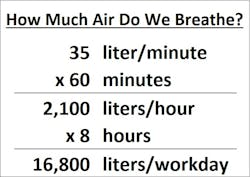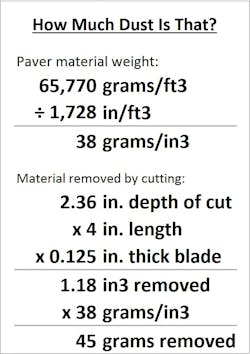If I seem obsessed with jobsite dust, it’s because lately I’ve been doing a lot of research in connection with our series on dust, which ran in the June and July issues of the magazine. The timing coincides with the start date of OSHA’s revised silica rule, which reduces the “permissible exposure limit” (PEL) for silica by half, from 100 micrograms (µg) per cubic meter to 50µg/m3 averaged over a continuous 8-hour period.
I wanted to know how much silica that is—a bucket full or a teaspoon full—which is how I ran across a wonderful series of blogs by Joel Guth, a third-generation mason and president of IQ Power Tools, which manufactures equipment designed to cut masonry while creating almost no dust. I’ve summarized Guth’s calculations here, but his original blogs at iqpowertools.com are well worth reading.
How Much Air Do We Breathe?
After setting the stage in the first blog, Guth uses the second to answer the first important question: How much air does the average worker breathe? The PEL specifies silica by weight per cubic meter, but breathing is measured in liters per minute.
Using established breathing rates for several routine activities, Guth estimates that an “average adult male working at a moderate level” (somewhere between “a brisk walk and mowing the lawn”) breathes 35 liters of air per minute, or 2,100 liters per hour (35 x 60), or 16,800 liters per workday (2,100 x 8). Dividing by the number of liters in a cubic meter, Guth concludes that the average male working moderately breathes 16.8 (16,800 ÷ 1,000) cubic meters of air in an 8-hour workday. (Guth uses a clever photo to show how much air this is.)
How Much Dust Is That?
The third blog focuses on how much dust cutting masonry produces and how much silica is in that dust. Guth begins with a standard 60 mm paver, which is 2.36 inches thick and weighs 65,770 grams per cubic foot or 38 grams per cubic inch (65,770 ÷ 1,728). He then imagines removing a 4-inch-long crosscut using a 1/8-inch blade (haven’t we all done this?), which takes out 1.18 cubic inches (2.36 x 4 x 0.125) of material. Multiplying by the weight of 1 cubic inch tells us that the removed material weighs 45 grams (1.18 x 38).
How Much Silica Is That?
But the OSHA rule uses micrograms, of which there are 1 million in a gram. So that single cut in the paver yields 45,000,000 micrograms of dust (45 x 1,000,000). According to tests that Guth’s company has conducted, average silica content in masonry materials is about 20 percent, so the amount of silica generated in a single paver cut is about 9,000,000 micrograms (45,000,000 x 0.2).
Poly, Water, Filters, and Respirators
If an average male working at a moderate pace breathes 16.8 cubic meters of air in an 8-hour workday, a 50µg/m3 PEL for silica means he is allowed to breathe 840µg of silica per day. Guth was writing in 2014, before OSHA revised it’s PEL, so the 840µg is smaller by half than the workday limit Guth arrived at, but compared with the 9,000,000µg of silica released by one paver cut, either PEL may as well be zero. It’s hard to imagine how even a short-term unprotected exposure would not exceed the limit. Which is really the point.
I understand remodelers’ complaints about the extra paperwork and red tape that OSHA’s silica rule requires. But that’s no reason to skimp on the solutions: use water for cutting, contain the work area, filter the air, and provide respirators.
You should be doing all of that already anyhow.
Related Content
About the Author
Sal Alfano
Executive Editor
Sal Alfano is executive editor for Professional Remodeler. [email protected], 202.365.9070



